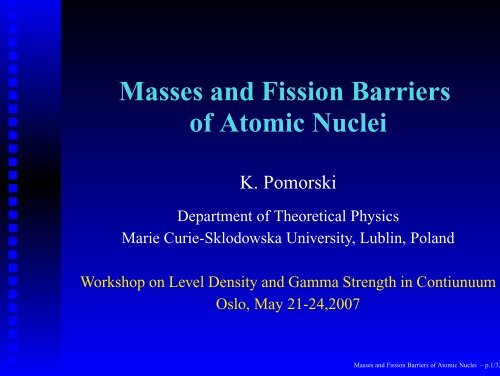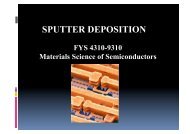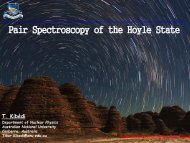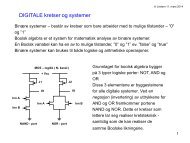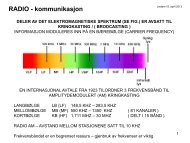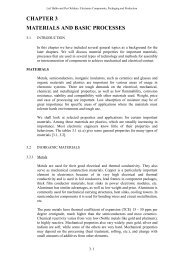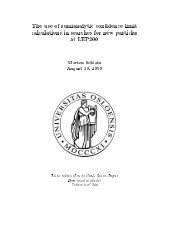Masses and Fission Barriers of Atomic Nuclei
Masses and Fission Barriers of Atomic Nuclei
Masses and Fission Barriers of Atomic Nuclei
You also want an ePaper? Increase the reach of your titles
YUMPU automatically turns print PDFs into web optimized ePapers that Google loves.
<strong>Masses</strong> <strong>and</strong> <strong>Fission</strong> <strong>Barriers</strong><br />
<strong>of</strong> <strong>Atomic</strong> <strong>Nuclei</strong><br />
K. Pomorski<br />
Department <strong>of</strong> Theoretical Physics<br />
Marie Curie-Sklodowska University, Lublin, Pol<strong>and</strong><br />
Workshop on Level Density <strong>and</strong> Gamma Strength in Contiunuum<br />
Oslo, May 21-24,2007<br />
<strong>Masses</strong> <strong>and</strong> <strong>Fission</strong> <strong>Barriers</strong> <strong>of</strong> <strong>Atomic</strong> <strong>Nuclei</strong> – p.1/33
My co-workers:<br />
Jerzy Dudek <strong>and</strong> Johann Bartel<br />
from IPHC <strong>and</strong> ULP, Strasburg, France<br />
Bożena Nerlo-Pomorska <strong>and</strong> Artur Dobrowolski<br />
from UMCS Lublin, Pol<strong>and</strong><br />
<strong>Masses</strong> <strong>and</strong> <strong>Fission</strong> <strong>Barriers</strong> <strong>of</strong> <strong>Atomic</strong> <strong>Nuclei</strong> – p.2/33
Program:<br />
• Introduction<br />
• Leptodermus expansion <strong>of</strong> energy functional<br />
• Role <strong>of</strong> different components <strong>of</strong> the liquid drop<br />
model<br />
• Lublin – Strasbourg Drop<br />
• Parameterization <strong>of</strong> nuclear shapes<br />
• Potential energy surfaces <strong>of</strong> fissioning nuclei<br />
• <strong>Fission</strong> barriers <strong>and</strong> saddle point masses<br />
• Shell <strong>and</strong> pairing energies<br />
• Summary <strong>and</strong> conclusions<br />
<strong>Masses</strong> <strong>and</strong> <strong>Fission</strong> <strong>Barriers</strong> <strong>of</strong> <strong>Atomic</strong> <strong>Nuclei</strong> – p.3/33
Liquid drop models:<br />
• C.F. von Weizsäcker, Z. Physik 96, 431 (1935).<br />
• H.A. Bethe, R.F. Bacher, Rev. Mod. Phys. 8, 82 (1936).<br />
• L. Meitner, O.R. Frisch, Nature 143, 239 (1939).<br />
• N. Bohr, J.A. Wheeler, Phys. Rev. 56, 426 (1939).<br />
• D.L. Hill, J.A. Wheeler, Phys. Rev. 89, 1102 (1953).<br />
• W.D. Myers, W.J. Świa¸tecki, Nucl. Phys. 81, 1 (1966).<br />
• H. von Groote, E. Hilf, Nucl. Phys. A129, 513 (1969).<br />
• K. Pomorski , J. Dudek, Phys. Rev. C67, 044316 (2003).<br />
Other models: droplet, Yukawa+exp., FRDM, TF, ETFSI<br />
<strong>Masses</strong> <strong>and</strong> <strong>Fission</strong> <strong>Barriers</strong> <strong>of</strong> <strong>Atomic</strong> <strong>Nuclei</strong> – p.4/33
Chart <strong>of</strong> known isotopes<br />
114<br />
Antony 2002<br />
Audi-Wapstra 1993<br />
Green’s β stability line<br />
82<br />
Z<br />
50<br />
28<br />
20<br />
8<br />
2<br />
2 8 20 28 50 82 126 184<br />
N<br />
Audi-Wapstra – 1654, Antony – 2766 isotopes with Z ≥ 8 <strong>and</strong> N ≥ 8.<br />
<strong>Masses</strong> <strong>and</strong> <strong>Fission</strong> <strong>Barriers</strong> <strong>of</strong> <strong>Atomic</strong> <strong>Nuclei</strong> – p.5/33
Nuclear energy functional<br />
The one-body density <strong>of</strong> a nucleus can be expressed as<br />
∫ ∫ ∫<br />
ρ = A . . . Ψ ⋆ Ψ dτ 2 · · · dτ A<br />
<strong>and</strong> the corresponding energy-density as<br />
∫ ∫ ∫<br />
η = . . . Ψ ⋆ ĤΨ dτ 2 · · · dτ A .<br />
The total energy <strong>of</strong> the nucleus is<br />
∫<br />
B = η d 3 r<br />
V<br />
<strong>Masses</strong> <strong>and</strong> <strong>Fission</strong> <strong>Barriers</strong> <strong>of</strong> <strong>Atomic</strong> <strong>Nuclei</strong> – p.6/33
Leptodermous expansion<br />
The total energy integral can be decomposed around diffused<br />
around a nuclear surface Σ:<br />
∮<br />
B = b vol A + dσ<br />
∫ ∞<br />
(η − b vol ρ) dr ⊥<br />
Σ<br />
= b vol A + γ (0) ∮<br />
0<br />
dσ + γ ′ κ a ∮<br />
κ dσ<br />
+ 1 2 γ ′′<br />
κκ a 2 ∮<br />
Σ<br />
Σ<br />
κ 2 dσ + γ ′ Γ a 2 ∮<br />
Σ<br />
Σ<br />
Γ dσ + . . . ,<br />
where κ = 1 R 1<br />
+ 1 R 2<br />
<strong>and</strong> Γ = 1<br />
R 1·R 2<br />
are the 1 st <strong>and</strong> the 2 nd<br />
order (Gauss) curvatures <strong>and</strong> R 1 <strong>and</strong> R 2 are the local main radii<br />
<strong>of</strong> the surface.<br />
<strong>Masses</strong> <strong>and</strong> <strong>Fission</strong> <strong>Barriers</strong> <strong>of</strong> <strong>Atomic</strong> <strong>Nuclei</strong> – p.7/33
Leptodermous expansion <strong>of</strong> the Skyrme energy<br />
functional:<br />
100 Sn Force: SkM * b vol =-15.387 MeV<br />
20<br />
1.4<br />
b sur<br />
r 0<br />
b curG<br />
b [MeV]<br />
10<br />
0<br />
1.3<br />
1.2<br />
r 0 [fm]<br />
-10<br />
0 10 20 30 1.1<br />
b cur [MeV]<br />
<strong>Masses</strong> <strong>and</strong> <strong>Fission</strong> <strong>Barriers</strong> <strong>of</strong> <strong>Atomic</strong> <strong>Nuclei</strong> – p.8/33
Fit <strong>of</strong> the liquid drop parameters to experimental<br />
binding energies <strong>of</strong> all known isotopes as function<br />
<strong>of</strong> the charge radius:<br />
30<br />
1<br />
δB<br />
b sur<br />
b [MeV]<br />
15<br />
0<br />
-15<br />
b curG<br />
b cur<br />
b vol<br />
0.5<br />
0<br />
-0.5<br />
< δB(Z,A) > [MeV]<br />
-30<br />
1.18 1.2 1.22 1.24 1.26 -1<br />
ch<br />
r 0 [fm]<br />
<strong>Masses</strong> <strong>and</strong> <strong>Fission</strong> <strong>Barriers</strong> <strong>of</strong> <strong>Atomic</strong> <strong>Nuclei</strong> – p.9/33
Lublin – Strasburg Drop model:<br />
M(Z, N; def) = ZM H + NM n − b elec Z 2.39<br />
+ b vol (1 − κ vol I 2 ) A<br />
+ b surf (1 − κ surf I 2 ) A 2/3 B surf (def)<br />
+ b cur (1 − κ cur I 2 ) A 1/3 B cur (def)<br />
+ 3 5 e2 Z 2<br />
Z<br />
B<br />
r0 ch Coul (def) − C 2<br />
4 A1/3 A<br />
+ E micr (Z, N; def) + E cong (Z, N)<br />
<strong>Masses</strong> <strong>and</strong> <strong>Fission</strong> <strong>Barriers</strong> <strong>of</strong> <strong>Atomic</strong> <strong>Nuclei</strong> – p.10/33
Fit to the 2766 experimental masses:<br />
Term Units LDM LSD<br />
b vol MeV -15.8484 -15.4920<br />
κ vol - 1.8475 1.8601<br />
b surf MeV 19.3859 16.9707<br />
κ surf - 1.9830 2.2938<br />
b cur MeV 0 3.8602<br />
κ cur - 0 -2.3764<br />
r 0 fm 1.18995 1.21725<br />
C 4 MeV 1.1995 0.9181<br />
δM MeV 0.732 0.698<br />
δV BZ>70 MeV 5.58 0.88<br />
M H =7.289034 MeV; M n =8.071431 MeV;<br />
K. Pomorski , J. Dudek, Phys. Rev. C67, 044316 (2003).<br />
b elec =1.433 eV<br />
<strong>Masses</strong> <strong>and</strong> <strong>Fission</strong> <strong>Barriers</strong> <strong>of</strong> <strong>Atomic</strong> <strong>Nuclei</strong> – p.11/33
LSD+YF mass deviation:<br />
M LSD - M exp [MeV]<br />
4<br />
0<br />
-4<br />
0 40 80 120 160<br />
N<br />
<strong>Masses</strong> <strong>and</strong> <strong>Fission</strong> <strong>Barriers</strong> <strong>of</strong> <strong>Atomic</strong> <strong>Nuclei</strong> – p.12/33
<strong>Masses</strong> <strong>of</strong> isotopes:<br />
120<br />
120<br />
100<br />
M LSD - M exp [MeV]<br />
100<br />
M TF - M exp [MeV]<br />
Z<br />
80<br />
60<br />
40<br />
-1 01234<br />
-2<br />
-3<br />
Z<br />
80<br />
60<br />
40<br />
-1 01234<br />
-2<br />
-3<br />
-4<br />
20<br />
0<br />
r.m.s. dev.= 0.698 MeV<br />
0 20 40 60 80 100 120 140 160 180<br />
N<br />
20<br />
0<br />
r.m.s. dev.= 0.757 MeV<br />
0 20 40 60 80 100 120 140 160 180<br />
N<br />
exp: The mass deviations are plotted for 2766 isotopes taken from the<br />
Chart <strong>of</strong> Nuclides by M.S. Antony, Strasbourg, 2002.<br />
LSD: K. Pomorski, J. Dudek, Phys. Rev. C67, 044316 (2003).<br />
TF: P. Möller, J.R. Nix, W.D. Myers, W.J. Świa¸tecki, At. Data Nucl.<br />
Data Tables 59, 185 (1995).<br />
<strong>Masses</strong> <strong>and</strong> <strong>Fission</strong> <strong>Barriers</strong> <strong>of</strong> <strong>Atomic</strong> <strong>Nuclei</strong> – p.13/33
LSD masses:<br />
120<br />
100<br />
M LSD - M exp [MeV]<br />
Z<br />
80<br />
60<br />
40<br />
-1 01234<br />
-2<br />
-3<br />
20<br />
0<br />
r.m.s. dev.= 0.698 MeV<br />
0 20 40 60 80 100 120 140 160 180<br />
N<br />
K. Pomorski , J. Dudek, Phys. Rev. C67, 044316 (2003).<br />
<strong>Masses</strong> <strong>and</strong> <strong>Fission</strong> <strong>Barriers</strong> <strong>of</strong> <strong>Atomic</strong> <strong>Nuclei</strong> – p.14/33
TF <strong>and</strong> LSD mass differences:<br />
140<br />
120<br />
E TF - E LSD = X 3 [MeV]<br />
100<br />
Z<br />
80<br />
60<br />
40<br />
20<br />
0<br />
X<br />
-2 -1 0 1<br />
0 50 100 150 200 250<br />
N<br />
Data plotted for 8757 isotopes taken from the mass table <strong>of</strong> P. Möller et al., At. Data Nucl. Data<br />
<strong>Masses</strong> <strong>and</strong> <strong>Fission</strong> <strong>Barriers</strong> <strong>of</strong> <strong>Atomic</strong> <strong>Nuclei</strong> – p.15/33<br />
Tables 59, 185 (1995).
TF <strong>and</strong> LSD mass differences:<br />
M LSD - M TF [MeV]<br />
2<br />
1<br />
0<br />
Sn<br />
M LSD - M TF [MeV]<br />
2<br />
1<br />
0<br />
Pb<br />
-1<br />
90 100 110 120 130 140<br />
A<br />
-1<br />
170 180 190 200 210 220 230<br />
A<br />
<strong>Masses</strong> <strong>and</strong> <strong>Fission</strong> <strong>Barriers</strong> <strong>of</strong> <strong>Atomic</strong> <strong>Nuclei</strong> – p.16/33
Predictive power <strong>of</strong> mass formulae<br />
Root means square deviations (δM in MeV) <strong>of</strong> theoretical <strong>and</strong><br />
experimental binding energies <strong>of</strong> 1654 isotopes taken from the<br />
Audi-Wapstra tables <strong>and</strong> 2766 isotopes from the Antony chart:<br />
Model<br />
δM(2766) δM(1654)<br />
LSD(2766) 0.698 0.610<br />
LSD(1654) 0.711 0.600<br />
TF-MS(1654) 0.757 0.655<br />
ETFSI(1888) 0.828 0.738<br />
ETFSI: S. Goriely, J.M. Pearson, <strong>and</strong> F. Tondeur, At. Data <strong>and</strong> Nucl. Data Tables 77, 311 (2001).<br />
<strong>Masses</strong> <strong>and</strong> <strong>Fission</strong> <strong>Barriers</strong> <strong>of</strong> <strong>Atomic</strong> <strong>Nuclei</strong> – p.17/33
Spherical harmonics expansion:<br />
6<br />
2<br />
4<br />
V LD [MeV]<br />
2<br />
0<br />
-2<br />
-4<br />
232 Th<br />
LSD<br />
λ max<br />
4<br />
6<br />
8<br />
-6<br />
-8<br />
-0.5 0 0.5 1 1.5 2 2.5 3 3.5<br />
β 2<br />
10<br />
12<br />
14<br />
R(θ) = R 0<br />
∞∑<br />
λ=0<br />
β λ P λ (cos θ)<br />
<strong>Masses</strong> <strong>and</strong> <strong>Fission</strong> <strong>Barriers</strong> <strong>of</strong> <strong>Atomic</strong> <strong>Nuclei</strong> – p.18/33
Modiffied Funny-Hills:<br />
232 Th LSD<br />
5<br />
4<br />
Gauss<br />
F-Hills<br />
β, λ max =14<br />
V LD [MeV]<br />
3<br />
2<br />
1<br />
0<br />
0.6 0.8 1 1.2 1.4 1.6 1.8 2 2.2<br />
R 12 /R 0<br />
˜ρ 2 s (z) = R2 0<br />
c f(a,B) (1 − u2 ) (1 + αu − B e −a2 u 2 ) ,<br />
where u = (z − z sh )/(c R 0 ). <strong>Masses</strong> <strong>and</strong> <strong>Fission</strong> <strong>Barriers</strong> <strong>of</strong> <strong>Atomic</strong> <strong>Nuclei</strong> – p.19/33
MFH shapes examples:<br />
α=0.00<br />
c=2.0<br />
a=2.00<br />
B=+0.00<br />
B=-0.60<br />
B=-0.90<br />
B=-0.99<br />
B=-1.00<br />
α=0.25<br />
c=1.6<br />
α=0.00<br />
B=+0.30<br />
B=+0.00<br />
B=-0.30<br />
B=-0.60<br />
B=-0.90<br />
c=1.2<br />
α=0.00<br />
B=+0.60<br />
B=+0.30<br />
B=+0.00<br />
B=-0.30<br />
B=-0.60<br />
<strong>Masses</strong> <strong>and</strong> <strong>Fission</strong> <strong>Barriers</strong> <strong>of</strong> <strong>Atomic</strong> <strong>Nuclei</strong> – p.20/33
PES <strong>of</strong> 240 Pu in the MFH space:<br />
-1809<br />
-1806<br />
-1803<br />
-1800<br />
-1803<br />
-1800<br />
-1797<br />
-1794<br />
0.20<br />
-1812<br />
-1806<br />
-1791<br />
-1791<br />
-1809<br />
-1803<br />
0.15<br />
-1794<br />
-1797<br />
-1806<br />
-1803<br />
-1806<br />
-1800<br />
-1803<br />
0.10<br />
-1806<br />
-1800<br />
-1809<br />
-1803<br />
0.05<br />
-1809<br />
-1809<br />
-1806<br />
-1803<br />
0.00<br />
-1803<br />
-1806<br />
-1806<br />
-1800<br />
-1809<br />
-1812<br />
-1806<br />
-1800<br />
-1803<br />
-0.05<br />
-1800<br />
-1803<br />
-1806<br />
-1803<br />
-1812<br />
-1809<br />
-0.10<br />
-1797<br />
-1800<br />
-1800<br />
-1803<br />
-0.15<br />
-1809<br />
-1806<br />
-1797<br />
-1800<br />
-1800<br />
-1800<br />
-1794<br />
-0.20<br />
-1797<br />
-1803<br />
-1806<br />
-1794<br />
-1791<br />
-0.25<br />
240<br />
94<br />
Pu<br />
146<br />
a=5-2c, B=h(3c-1)<br />
E_tot<br />
0.8 0.9 1.0 1.1 1.2 1.3 1.4 1.5 1.6 1.7 1.8 1.9<br />
c<br />
E [MeV]<br />
-1790.0<br />
-1791.0<br />
-1792.0<br />
-1793.0<br />
-1794.0<br />
-1795.0<br />
-1796.0<br />
-1797.0<br />
-1798.0<br />
-1799.0<br />
-1800.0<br />
-1801.0<br />
-1802.0<br />
-1803.0<br />
-1804.0<br />
-1805.0<br />
-1806.0<br />
-1807.0<br />
-1808.0<br />
-1809.0<br />
-1810.0<br />
-1811.0<br />
-1812.0<br />
-1813.0<br />
h<br />
LSD with shell <strong>and</strong> pairing corrections obtained with the Yukawa-folded single particle potential.<br />
<strong>Masses</strong> <strong>and</strong> <strong>Fission</strong> <strong>Barriers</strong> <strong>of</strong> <strong>Atomic</strong> <strong>Nuclei</strong> – p.21/33<br />
A. Dobrowolski, K. Pomorski, J. Bartel, Phys. Rev. C75(2007) 024613.
<strong>Fission</strong> barrier heights:<br />
16<br />
δV B (LSD)=1.74 MeV<br />
LSD<br />
V B<br />
th -VB<br />
exp [MeV]<br />
12<br />
8<br />
4<br />
0<br />
-4<br />
15 20 25 30 35 40<br />
Z 2 /A<br />
Deformation dependent congruence energy term is included here according to:<br />
W.D. Myers, .J. Świa¸ tecki, Nucl. Phys. A612 (1997) 249.<br />
K. Pomorski, J. Dudek, Int. Journ. Mod. Phys. E13 (2004) 107.<br />
<strong>Masses</strong> <strong>and</strong> <strong>Fission</strong> <strong>Barriers</strong> <strong>of</strong> <strong>Atomic</strong> <strong>Nuclei</strong> – p.22/33
Saddle point masses:<br />
80<br />
M exp.<br />
M LSD<br />
Cm<br />
70<br />
Cf<br />
M sadd. [MeV]<br />
60<br />
50<br />
Th<br />
U<br />
Pu<br />
40<br />
r.m.s. dev. = 0.382 MeV<br />
230 235 240 245 250<br />
A<br />
<strong>Masses</strong> <strong>and</strong> <strong>Fission</strong> <strong>Barriers</strong> <strong>of</strong> <strong>Atomic</strong> <strong>Nuclei</strong> – p.23/33
Stiffness at the saddle point:<br />
45<br />
45<br />
V [MeV]<br />
40<br />
35<br />
172 Yb<br />
β 2 = 2.0<br />
MS-LD<br />
LSD<br />
V [MeV]<br />
40<br />
35<br />
172 Yb<br />
β 2 = 2.0<br />
MS-LD<br />
LSD<br />
30<br />
YF<br />
30<br />
YF<br />
25<br />
25<br />
0.2 0.4 0.6 0.8 1<br />
β 4<br />
-0.4 -0.2 0 0.2<br />
β 6<br />
<strong>Masses</strong> <strong>and</strong> <strong>Fission</strong> <strong>Barriers</strong> <strong>of</strong> <strong>Atomic</strong> <strong>Nuclei</strong> – p.24/33
Shell <strong>and</strong> pairing corrections:<br />
E tot = E macro + δE shell + δE pair<br />
δE shell = ∑ occ<br />
2e ν − 〈 ∑ occ<br />
2e ν 〉<br />
E pair = E BCS − ∑ occ<br />
2e ν<br />
δE pair = E pair − 〈 E pair 〉<br />
δE shell + δE pair = E BCS − 〈 E BCS 〉<br />
<strong>Masses</strong> <strong>and</strong> <strong>Fission</strong> <strong>Barriers</strong> <strong>of</strong> <strong>Atomic</strong> <strong>Nuclei</strong> – p.25/33
Harmonic oscillator s.p. energy sum<br />
700<br />
600<br />
E<br />
10<br />
Σ N i=1 e i [/hω 0 ]<br />
500<br />
400<br />
300<br />
200<br />
100<br />
Ē=1.0878 N 4/3 /hω 0<br />
5<br />
0<br />
-5<br />
Harmonic oscillator<br />
-10<br />
∆E [/hω 0 ]<br />
0<br />
0 100 200 300 400 500 600<br />
N 4/3<br />
0 100 200 300 400 500<br />
N<br />
10<br />
10<br />
5<br />
5<br />
∆E [/hω 0 ]<br />
0<br />
∆E [/hω 0 ]<br />
0<br />
-5<br />
-5<br />
-10<br />
-10<br />
1 2 3 4 5 6 7 8<br />
N 1/3<br />
2 4 6 8 10<br />
e i [/hω 0 ]<br />
K. Pomorski, Phys. Rev. C70 (2004) 044306. <strong>Masses</strong> <strong>and</strong> <strong>Fission</strong> <strong>Barriers</strong> <strong>of</strong> <strong>Atomic</strong> <strong>Nuclei</strong> – p.26/33
Gogny mean-field Hamiltonian:<br />
Σ Z i=1 (e i - V 0 ) [MeV]<br />
7000<br />
6000<br />
5000<br />
4000<br />
3000<br />
2000<br />
1000<br />
0<br />
40<br />
Gogny<br />
a Z 4/3 20<br />
0<br />
V 0 = -71.25 MeV<br />
-20<br />
a= 11.119 MeV<br />
-40<br />
0 100 200 300 400 500 600<br />
Z 4/3<br />
Σ Z i=1 (e i - V 0 ) - a Z 4/3 [MeV]<br />
protons<br />
0 50 100 150 200<br />
Z<br />
Σ N i=1 (e i - V 0 ) [MeV]<br />
8000<br />
6000<br />
4000<br />
2000<br />
0<br />
40<br />
Gogny<br />
a N 4/3 20<br />
0<br />
V 0 = -80.91 MeV<br />
-20<br />
a= 11.238 MeV<br />
-40<br />
0 200 400 600 800 1000<br />
N 4/3<br />
Σ N i=1 (e i - V 0 ) - a N 4/3 [MeV]<br />
neutrons<br />
0 50 100 150 200<br />
N<br />
K. Pomorski, Phys. Rev. C70 (2004) 044306. <strong>Masses</strong> <strong>and</strong> <strong>Fission</strong> <strong>Barriers</strong> <strong>of</strong> <strong>Atomic</strong> <strong>Nuclei</strong> – p.27/33
N -folding <strong>of</strong> the s.p. energy sum<br />
E sum (n) =<br />
n∑<br />
ν=1<br />
The energy sum smoothed in N 1/3 -space is given by:<br />
( )<br />
N∑<br />
max<br />
2 E sum (n) N 1/3 − n 1/3<br />
〈 E sum (N) 〉 =<br />
j<br />
3 n 2/3 γ<br />
N min<br />
e ν<br />
where γ ≈ 0.7 is the smearing width <strong>and</strong><br />
j(u) = 1 √ π<br />
e −u2 ( 35<br />
16 − 35 8 u2 + 7 4 u4 − 1 6 u6 )<br />
.<br />
K. Pomorski, Phys. Rev. C70 (2004) 044306.<br />
<strong>Masses</strong> <strong>and</strong> <strong>Fission</strong> <strong>Barriers</strong> <strong>of</strong> <strong>Atomic</strong> <strong>Nuclei</strong> – p.28/33
Strutinsky <strong>and</strong> new shell energy<br />
5<br />
5<br />
0<br />
0<br />
E shell [MeV]<br />
-5<br />
-10<br />
208 Pb<br />
E shell [MeV]<br />
-5<br />
-10<br />
208 Pb<br />
-15<br />
new<br />
protons<br />
old<br />
diff.<br />
-20<br />
0.6 0.8 1 1.2 1.4 1.6<br />
c<br />
-15<br />
new<br />
neutrons<br />
old<br />
diff.<br />
-20<br />
0.6 0.8 1 1.2 1.4 1.6<br />
c<br />
10<br />
10<br />
E shell [MeV]<br />
5<br />
0<br />
-5<br />
-10<br />
protons<br />
232 Th<br />
new<br />
old<br />
diff.<br />
E shell [MeV]<br />
5<br />
0<br />
-5<br />
-10<br />
neutrons<br />
232 Th<br />
new<br />
old<br />
diff.<br />
0.6 0.8 1 1.2 1.4 1.6<br />
c<br />
0.6 0.8 1 1.2 1.4 1.6<br />
c<br />
<strong>Masses</strong> <strong>and</strong> <strong>Fission</strong> <strong>Barriers</strong> <strong>of</strong> <strong>Atomic</strong> <strong>Nuclei</strong> – p.29/33
Plateau condition:<br />
2.6<br />
new<br />
p<br />
n<br />
208 Pb<br />
c=1.2<br />
2.6<br />
old<br />
208 Pb<br />
c=1.2<br />
E shell [MeV]<br />
2.4<br />
2.2<br />
2<br />
E shell [MeV]<br />
2.4<br />
2.2<br />
2<br />
1.8<br />
1.8<br />
0.6 0.7 0.8 0.9 1<br />
γ<br />
0.9 1 1.1 1.2 1.3 1.4 1.5<br />
γ S [/hω 0 ]<br />
K. Pomorski, Phys. Rev. C70 (2004) 044306.<br />
<strong>Masses</strong> <strong>and</strong> <strong>Fission</strong> <strong>Barriers</strong> <strong>of</strong> <strong>Atomic</strong> <strong>Nuclei</strong> – p.30/33
N -folding <strong>of</strong> the BCS energy:<br />
E BCS (n) = 2 ∑ ν<br />
v 2 ν e ν − G ∑ ν<br />
v 4 ν − ∆2 /G<br />
The BCS energy smoothed in N 1/3 -space is given by:<br />
〈 E BCS (N) 〉 =<br />
N∑<br />
max<br />
n=N min<br />
2 E BCS (n)<br />
3 n 2/3 j<br />
(<br />
N 1/3 − n 1/3<br />
γ<br />
where<br />
j(u) = 1 √ π<br />
e −u2 ( 35<br />
16 − 35 8 u2 + 7 4 u4 − 1 6 u6 )<br />
.<br />
K. Pomorski, B. Nerlo-Pomorska, Physica Scripta T125 (2006) 21. <strong>Masses</strong> <strong>and</strong> <strong>Fission</strong> <strong>Barriers</strong> <strong>of</strong> <strong>Atomic</strong> <strong>Nuclei</strong> – p.31/33
Smooth pairing energy<br />
0<br />
-0.1<br />
<br />
N<br />
e i [/hω 0 ]<br />
E BCS (N ) - Σ<br />
i=1<br />
-0.2<br />
-0.3<br />
-0.4<br />
-0.5<br />
-0.6<br />
ε = 0.45<br />
G = 0.285/N 2/3 [/hω 0 ]<br />
-0.7<br />
20 40 60 80 100 120 140 160 180 200<br />
N<br />
K. Pomorski, B. Nerlo-Pomorska, Physica Scripta T125 (2006) 21.<br />
B. Nerlo-Pomorska, K. Pomorski, Int. Journ. Mod. Phys. E16 (2007) 328.<br />
<strong>Masses</strong> <strong>and</strong> <strong>Fission</strong> <strong>Barriers</strong> <strong>of</strong> <strong>Atomic</strong> <strong>Nuclei</strong> – p.32/33
Summary <strong>and</strong> conclusions<br />
• Lublin Strasburg Drop, which apart traditional<br />
liquid drop terms contains the curvature energy,<br />
describes well the masses <strong>of</strong> known isotopes.<br />
• The fission barriers as well as the saddle point<br />
masses are reproduced well by the LSD model.<br />
• New method <strong>of</strong> evaluation <strong>of</strong> the Strutinsky<br />
smoothed energy by folding in the particle<br />
number space is proposed.<br />
• The N -folding method can be applied to obtain<br />
the average pairing energy.<br />
• Large scale calculation <strong>of</strong> the nuclear mass table<br />
is planned.<br />
<strong>Masses</strong> <strong>and</strong> <strong>Fission</strong> <strong>Barriers</strong> <strong>of</strong> <strong>Atomic</strong> <strong>Nuclei</strong> – p.33/33


